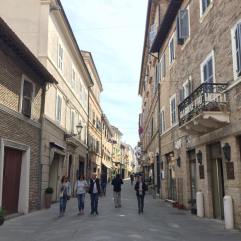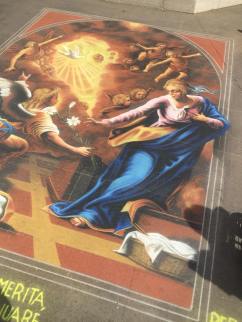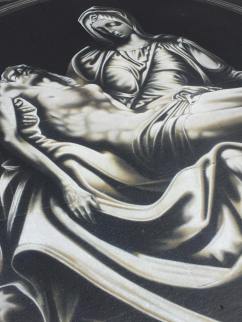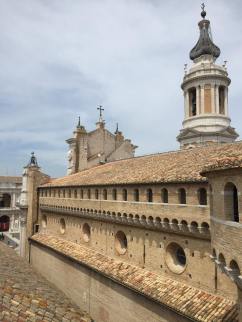I have visited Le Marche region several times, spending holidays and weekend breaks as a couple when I was just married and returning there several times with kids and family over the years. It’s a part of Italy that I love very much because of its resemblance to my homeland (Abruzzo), this is why I enthusiastically accepted to participate in the Photowalks launched by Le Marche tourism agency as part of their promotional strategy.
Located in central Italy between the Apennines and the Adriatic sea, just like Abruzzo this region enjoys a very varied landscape going from mountains through hills to beautiful beaches. In Le Marche hinterland there are ancient medieval boroughs, whereas the centers along the coast are mostly modern and suited to summer tourism, thanks to the low marine waters and fine sandy beaches. There is only one high, rocky cliff called Monte Conero, while the city of Ancona is the main port of the region.

REACHING LORETO
Loreto is the cradle of Le Marche’s spirituality and one of the most important Marian pilgrimage destinations in Europe and in the world, a treasure chest of art and culture nestled in the heart of the Conero Riviera.
To reach Loreto we decided to travel as much sustainable as possible, taking advantage of public transports: we booked a regional train from Pescara (1h47 ride for less than 10 €), then a public bus from Loreto train station to the uphill town (less than 2 €). In just few minutes we arrived in the enchanting borgo!
8 THINGS TO DO IN LORETO IN 4 HOURS
-
Visit the Historic Museum of Aeronautics
According to the popular legend, the city of Loreto hosts the “Little House of the Blessed Virgin” that was moved from Nazareth to Italy by the translation on “angel wings”. The Madonna of Loreto was then elected by Pope Benedict XV “Patroness of the Aircrafts”: the airmen of Italy, both civil and military, venerate her as their protectress and rescuer from the dangers of the skies.
Not far from the main basilica, we visited the Historic Museum of Aeronautics hosting an exclusive collection of flight equipments as well as authentic military uniforms of the Italian Air Force. Inside the museum it is also possible to live a real flight experience with the flight simulator, that is still used nowadays to train airmen-to-be. The entrance to the museum is free!
-
Learn the art of devotional tatooing
Tattoos have become a very popular fashion nowadays however probably no one except the locals know that in Le Marche the tattoo art was already practiced more than 500 years ago! The difference is that by that time the tattoo was actually a mystical and devotional fact.
Tradition has it that during the Crusades, the soldiers would tattoo the religious symbols of their faith to be recognized by the “infidels” and to guarantee the ecclesiastical burial, that in ancient times was denied to those who succumbed in battles and did not present symbols of their religion. The tattoo was therefore a mark of recognition, as it represented Christianity.
This tradition has gone through the centuries reaching its maximum spread in Le Marche where the Sanctuary of the Holy House of Loreto is located. Here the pilgrims from all over Europe gathered after a long journey of faith and started painting the memory of so much devotional ardor on their skin. Near the Sanctuary, in fact, there were numerous “markers”, who with barn boards and awls, called feathers, tattooed to the travelers the signs of their love for the Madonna, Jesus, the Holy Spirit and Saint Francis.
-
Admire the artwork of Madonnari
In Loreto art is everywhere and expressed in all its forms, including the ancient tradition of “Madonnari”. The majestic Piazza della Madonna, in front of the Basilica, is always home to street artists who reproduce with devotion some of the most beautiful and significant religious paintings of all time, using simple colored chalks. Recommendation: lease leave a tip to support these artists and their amazing paintings!
-
Relax in the beautiful Piazza della Madonna
The majestic Piazza della Madonna opens in front of the Basilica of the Loreto, and constitutes its architectural and environmental introduction. It was conceived in the early 16th century by Italian architect and painter Bramante, whose project included the façade of the church and the edification of the Apostolic Palace on three sides so as to form a closed environment. The project remained unfinished but the two wings of the building testify the genius of Bramante’s urban and architectural planning.
-
Explore the Basilica and the Holy House
The Sanctuary of Loreto is a rich, huge basilica enclosing a magnificent marble casing which ecompasses what is believed to be the Nazareth house where the Virgin Mary was born and received the Angel’s visit. According to the tradition when the Holy Land was occupied by the Muslims, angels carried Mary’s native house from Nazareth to Loreto. Devotion and pilgrimage rose to great levels, therefore in 1469 the construction of a basilica was ordered by Pope Paul II, and all the greatest architects of the time – Ponticelli, Bramante, Sansovino, Giuliano da Sangallo – worked on the project. Three different architectural units are encased one inside the other: the outside basilica, the marble mausoleum inside, which surrounds the Holy House. Recommendation: the Holy House is a sacred place, please enter in silence and respect the emotional intensity that has been living there for centuries!
-
Climb to the walkways
The majesty of the Basilica is also due to its massive fortifications that were built in defense of the Sanctuary against the incursions of the Turkish fleet in the Adriatic sea over the centuries. Especially evocative are the walkways or Camminamenti di Ronda that were used in the past to scan the horizon and ensure the security of the citadel. On top of the walkways you can also admire the amazing territory around Loreto! Recommendation: if you suffer from claustrophobia please don’t go to the walkways, as they can be reached only by climbing a steep and very narrow staircase.
-
Taste wine under the basilica
No, this is no joke! I was surprised just like you readers to discover a wine shop and a fabulous barrel room under the basement of the church. Through legacies, donations and purchases as well, the Church of Santa Maria di Loreto features a 1400 hectares farm producing wine, olive oil, honey and pasta. My favourite drink was Rosso del Conero DOP.
-
Eat local Ciauscolo
Loreto is full of food shops and we finally ate a local sausage called Ciauscolo (from the Latin “cibusculum” = small food, small meal). Ciauscolo is made of pork meat and has an intense and fragrant aroma, with notes of smoke and garlic. It is spread on bread, its softness is obtained from the composition of the dough and the specific processing methods handed down from the rural tradition. Price is approx 15 € / kg.

Special thanks to:
- Regione Marche and its social media team for having me
- Silvia Badriotto for the wonderful opportunity to explore Loreto
- Hotel Centrale‘s owner for getting me a private coach to the train station after I missed the only possible bus and with no other taxi available at the horizon!
All the best!


This work is licensed under a Creative Commons Attribution-NonCommercial-ShareAlike 4.0 International License.



























Leave a comment